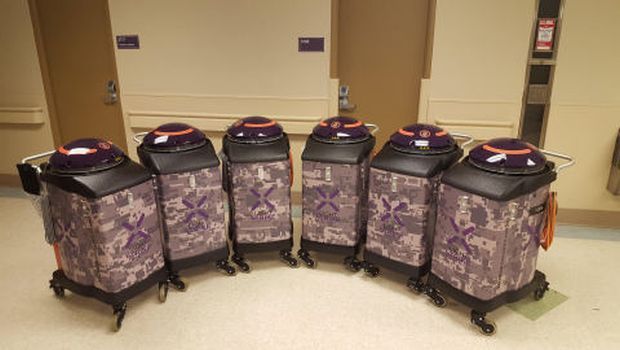Phoenix VA Health Care System Deploys Germ-Zapping Robots to Boost Veteran Safety


The Phoenix Veterans Affairs (VA) Health Care System is the first hospital in Arizona to deploy Xenex LightStrike™ Germ-Zapping Robots™ to destroy deadly bacteria lurking on hospital surfaces that can cause hospital-acquired infections (HAI). The portable room disinfection system utilizes pulsed xenon ultraviolet (UV) light and is effective against even the most dangerous superbugs and multi-drug resistant organisms (MDRO), including methicillin-resistant Staphylococcus aureus (MRSA), Clostridium difficile (C. diff), VRE, norovirus and influenza. Additionally, the Xenex Germ-Zapping Robot has been proven effective against both the Ebola virus and anthrax, and can easily be incorporated into a facility’s disease containment and biodefense strategy.
Pulsed xenon UV disinfection is an environmentally-friendly technology and exceeds both Presidential Executive Orders and VA Directives regarding sustainability and green procurement. Prior to implementing Xenex, the Phoenix VA used a mercury UV disinfection system and as a result, the facility’s OR experienced a degradation of materials including the cracking and yellowing of plastics. The materials damage associated with continuous mercury UV is a newly identified problem associated with mercury UV technology and the Phoenix VA was among the first in the nation to identify this issue.
To date, 20 peer-reviewed studies showing the effectiveness of pulsed xenon UV in reducing pathogens from the environment have been published, including eight studies that reported a decrease in patient infection rates when the pulsed xenon UV technology was used. Five of the environmental studies were accomplished by VA researchers including Dr. Chetan Jinadatha of Central Texas Veterans Health Care System, who found manual cleaning plus pulsed xenon UV light disinfection was far more effective than traditional cleaning methods at eliminating MRSA bacteria and was 23 percent faster when integrated into the room cleaning process. More importantly, numerous healthcare organizations using Xenex LightStrike robots have reported significant reductions in C. diff, MRSA, VRE and Surgical Site Infection (SSI) rates. This is evidenced in multiple published peer-reviewed outcome studies showing 50-100 percent reductions in HAI rates.
In addition to being the first hospital in Arizona, the Phoenix VA is the first VA facility in the Southwest Health Care Network (VISN 18) to deploy this innovative, leading-edge patient safety technology. The Phoenix VA joins 40 VA facilities and more than 350 hospitals across the nation who have added the Xenex LightStrike robot to their disinfection arsenals. During the implementation, as a tribute to the military, the Phoenix VA named its six LightStrike robots after the commander-in-chief and five sister services: Chief, Army, Navy, Air Force, Marines and Coast Guard.
“We want to do everything possible to provide a clean environment and enhance patient safety at our facility to reduce the risk of hospital acquired infections,” said Kenneth Carter, chief of environmental management services for the Phoenix VA. “One infection is one too many, so enlisting the help of the Xenex robots will help us achieve our goal of zero infections. This investment in a proven technology is important and underscores our commitment to patient care and the veterans we serve.”
The Xenex Germ-Zapping Robots are an adjunctive step in the hospital’s cleaning process. Operated by the hospital’s EVS team, they are brought into a room after traditional cleaning has taken place to destroy microscopic germs and bacteria that may be lurking on high touch surfaces, such as bed rails, tray tables, door knobs and remote controls. The portable Xenex system can disinfect a typical patient or procedure room in four or five minute cycles (depending on robot model) without warm-up or cool-down times. It can be used in any department and in any unit within a healthcare facility, including isolation rooms, operating rooms, general patient care rooms, contact precaution areas, emergency rooms, bathrooms and public spaces.
Source: Xenex Disinfection Services
IDEA in Action: A Strategic Approach to Contamination Control
January 14th 2025Adopting IDEA—identify, define, explain, apply—streamlines contamination control. Infection control professionals can mitigate risks through prevention, intervention, and training, ensuring safer health care environments and reducing frequent contamination challenges.
Top 7 Infection Control Today Articles of 2024: Insights and Innovations
December 30th 2024From advanced sterilization methods to combating antimicrobial resistance, Infection Control Today’s top articles of 2024 delivered actionable strategies for safer healthcare environments and improved patient outcomes.
Redefining Competency: A Comprehensive Framework for Infection Preventionists
December 19th 2024Explore APIC’s groundbreaking framework for defining and documenting infection preventionist competency. Christine Zirges, DNP, ACNS-BC, CIC, FAPIC, shares insights on advancing professional growth, improving patient safety, and navigating regulatory challenges.
Pula General Hospital Celebrates Clean Hospitals
December 16th 2024Learn how Pula General Hospital in Croatia championed infection prevention and environmental hygiene and celebrated Clean Hospitals Day to honor cleaning staff and promote advanced practices for exceptional patient care and safety.
Tackling Health Care-Associated Infections: SHEA’s Bold 10-Year Research Plan to Save Lives
December 12th 2024Discover SHEA's visionary 10-year plan to reduce HAIs by advancing infection prevention strategies, understanding transmission, and improving diagnostic practices for better patient outcomes.
Environmental Hygiene: Air Pressure and Ventilation: Negative vs Positive Pressure
December 10th 2024Learn more about how effective air pressure regulation in health care facilities is crucial for controlling airborne pathogens like tuberculosis and COVID-19, ensuring a safer environment for all patients and staff.